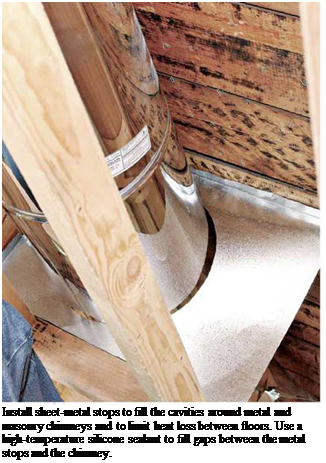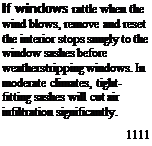LEAKY DUCTWORK
Because ductwork usually runs through basements or unconditioned crawl spaces, sealing it will reduce heat loss and subfloor moisture being drawn into living areas. Leaky ducts can waste 25 percent to 30 percent of total heating/cooling costs. Supply ducts most often leak where they take off from the main supply trunk, at section joints, and where ducts join register boots. Ironically, many leaks are caused by fabric duct tape that has dried out and cracked after a few years. Even if it looks intact, remove fabric duct tape.
Living space
|
Register boot
|
Secure joints between duct sections and fittings with at least three sheet-metal screws. Then wrap the joints with aluminum duct tape—not fabric duct tape! Apply fiber-reinforced mastic to hand – snipped and swivel joints.
There are three ways to reduce duct heat loss. Apply aluminum duct tape to joints between sections and to the factory-formed joints where round ducts snap together. Along hand-snipped or swivel joints, which aren’t as airtight, seal ducts with fiber-reinforced mastic, which you can apply generously to joints, using a brush or your hand (wearing disposable plastic gloves). Finally, to further reduce heat loss and condensation, insulate ducts in unconditioned spaces. Wrap l-in.-thick, foil-backed batts around the outside of the ducts; avoid interior duct linings such as ductboard, which can reduce airflow, absorb moisture, and grow mold.
Weatherstripping can reduce air leaks around doors and windows. Door weatherstripping is discussed in Chapter 6; two of the more popular types, tubular and metal-leaf, are also appropriate for windows. Install tubular weatherstripping for casement or awning windows, which are hinged as doors are and thus will seat solidly against compressible stripping. Metal-leaf stripping offers a tighter seal for double-hung windows, but installing it requires removing interior stops and possibly planing down sashes.
Interior door and window casing may leak air if there’s not a good paint seal to surrounding

![]()
 walls. If you notice gaps or cracks around the perimeters of the casing, caulk them with acrylic latex caulk, which you can tool smooth with an index finger. (Wash up with warm, soapy water.) Allow the caulk to cure before painting it.
walls. If you notice gaps or cracks around the perimeters of the casing, caulk them with acrylic latex caulk, which you can tool smooth with an index finger. (Wash up with warm, soapy water.) Allow the caulk to cure before painting it.
Gaps around exterior casing are most common on south-facing walls, where the sun is strongest. Typically, wood trim shrinks across its width, creating gaps where siding abuts. Fill gaps with exterior acrylic latex or siliconized latex caulk. (Pure silicone caulks don’t paint well, and many polyurethane caulks have poor UV resistance.) Because caulking alone is not terribly durable, paint it as soon as it has cured. To effectively block air and moisture infiltration, the edges of door and window frames should be caulked, flashed, recaulked (over flashing strips), and then recased, as shown on p. 129.
Any building material that is sufficiently impermeable to slow the flow of air and airborne moisture is considered an air-flow retarder, even if that’s not its primary function. If a retarder is installed specifically to stop water vapor, it’s called a vapor barrier. Most houses have both interior and exterior air-flow retarders: house – wrap or building paper, flashing, sheathing and siding on the outside, and drywall or plaster
In cold and very cold climates, polyethylene vapor barriers on the living-space side of insulation may prevent water vapor from condensing inside walls, which can lead to peeling paint, mold, and, in extreme cases, rotted framing.
inside. (Housewraps such as Tyvek are semipermeable: They keep rain out but allow water vapor trapped in walls to migrate outward.)
Some insulation, such as high-density cellulose and polyurethane foams, can be considered airflow retarders, as discussed later in this chapter.
![]()
 In cold and very cold climates, there should be a polyethylene vapor barrier installed on the living-space side of the insulation to prevent warm, moist air from migrating into wall cavities and condensing there during cold weather. Several things to note about vapor barriers: To be effective, they must be continuous—no gaps or
In cold and very cold climates, there should be a polyethylene vapor barrier installed on the living-space side of the insulation to prevent warm, moist air from migrating into wall cavities and condensing there during cold weather. Several things to note about vapor barriers: To be effective, they must be continuous—no gaps or







Leave a reply